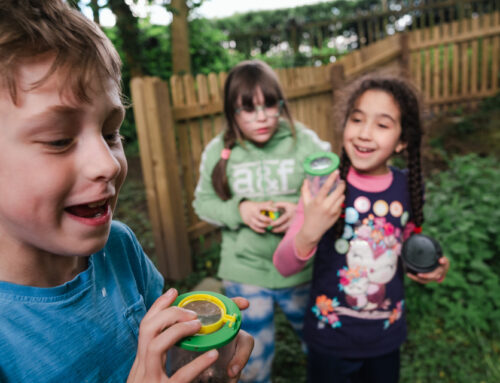Extension and enrichment are two ways of making learning more challenging for learners with higher ability. This article discusses the difference between them and provides examples of each, as well as self-directed projects that offer both enrichment and extension, in a variety of subjects.
What Is the Difference Between Extension and Enrichment?
Although subtle, it helps to remember the difference between these two forms of challenging high potential learners if we start with the meanings of the words:
Extension means to enlarge or extend something, usually in scope or operation. For example, extending a house by building more rooms.
Enrichment means to enrich something, usually by adding something different to it. For example, enriching soil by adding something to improve its quality.
In education terms, extension usually means to extend the learning in the lesson to make it more challenging. On the other hand, enrichment means doing something beyond the classroom or in addition to the main lesson that will enrich the learning, often allowing students to explore their interests. More of the same work and harder problems are not examples of extension and enrichment.
Why Do High Potential Learners Need Extension and Enrichment?
It can be argued that all children need enrichment in their learning, whereas extension is only needed by some children who are not being challenged by regular, enriched learning. Enrichment offer high potential learners the opportunity to develop their interests in a way that empowers them to go deeper and doesn’t ‘put a lid’ on their learning. Moreover, providing enriched learning for all, means that more children will be engaged and able to show what they are capable of.
Extension and enrichment provide opportunities for high potential learners, who are able to cover the basics very quickly, to be challenged, develop critical skills and build resilience. They are important in meeting the learning needs of able children and are robustly proven in research to lead to higher achievement and better wellbeing.
What Do Extension and Enrichment Look Like?
Extension is often a differentiated class activity that takes into account the higher order thinking skills of analysing, evaluating, creating and problem solving. These questions and activities will often activate divergent thinking, development of different perspectives and seeking of alternative solutions.
Enrichment is usually learning outside of the normal curriculum and can take many forms. The examples most often used in a school setting are enrichments projects, school trips and outside speakers. It can also take the form of homework projects, or visits to sites of interest or museums and galleries to learn more about the topic or to experience it first-hand. These activities will serve to engage learners and deepen their learning by building connections to other topics, subjects or personal experiences.
In particular, self-directed projects that offer a choice of what area to learn about, can be classed as both extension and enrichment if the project question is aimed at a higher order thinking level. Projects that have both an outcome/product and an audience to share it with are of the highest quality.
Below are some examples of extension and enrichment on various popular topic areas, together with a project suggestion to illustrate how high potential learners can be challenged.
Topic: Our Place in the World
Lesson: Finding out about our town.
Extension Activity: What makes a town a good place to live?
Enrichment Example: Visiting some of the landmarks in our town and finding out why they are important.
Project Suggestion: How can we rate our town compared to other places in England? Outcome/audience: Presentation in assembly.
Topic: World War II
Lesson: The effects of World War II on children.
Extension Activity: Compare the effects of the war on children today and in 1940s England.
Enrichment Example: Outside speaker talking about what it was like being a child in the War.
Project Suggestion: What could be done to make the lives of children living in war-torn countries better? Outcome/audience: Write a letter to your MP/a charity.
Topic: Rainforests
Lesson: Where rainforests are located.
Extension Activity: What can be concluded about places where rainforests are located?
Enrichment Example: Create a rainforest mural/world map as a class or in a group.
Project Suggestion: What would be needed to create a rainforest environment in the UK? Outcome/audience: An annotated diagram or animation to be shown on a website.
Topic: Angles
Lesson: What an angle is.
Extension Activity: What are the different types of angles used for/found in? Can you spot any patterns?
Enrichment Example: Take a protractor and investigate what angles you can find in our classroom.
Project Suggestion: How does knowing about angles help me in navigation? Outcome/audience: PowerPoint to share with the rest of the class.
Topic: Macbeth
Lesson: Who the characters are.
Extension Activity: Sort the characters in Macbeth into a classification system that will be helpful to you in thinking about their personalities.
Enrichment Example: Read a section of the play that illustrates the personalities of the main characters, taking parts in groups.
Project Suggestion: Decide who you feel has the most ‘character’ giving evidence for your choice. Outcome/audience: Use the Padlet app in less than 60 words to share with the year group.
Challenging high potential learners can be done through both enrichment and extension. Whilst enrichment is suitable for most learners to help them to engage and deepen their learning experience, extension is used to challenge those who master the main material of the lesson quickly. Good quality (those that involve an outcome and an audience for it) self-directed projects offer both extension and enrichment in a format that suits many high potential learners and helps them to develop independent learning skills.

About the author: Rebecca Howell is Potential Plus UK’s Senior Education Consultant. She leads various aspects of the organisation, including oversight of the assessment and advice services. She is passionate about leadership and developing new services to support members. With a background in educational leadership, she has 3 children with high learning potential/dual or multiple exceptionality.






